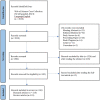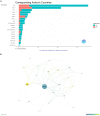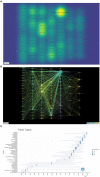Microbial dysbiosis in systemic lupus erythematosus: a scientometric study
- PMID: 38863759
- PMCID: PMC11166128
- DOI: 10.3389/fmicb.2024.1319654
Microbial dysbiosis in systemic lupus erythematosus: a scientometric study
Abstract
Introduction: Systemic lupus erythematosus (SLE) is a chronic autoimmune disease. Mounting evidence suggests microbiota dysbiosis augment autoimmune response. This study aims to provide a systematic overview of this research field in SLE through a bibliometric analysis.
Methods: We conducted a comprehensive search and retrieval of literature related to microbial researches in SLE from the Web of Science Core Collection (WOSCC) database. The retrieved articles were subjected to bibliometric analysis using VOSviewer and Bibliometricx to explore annual publication output, collaborative patterns, research hotspots, current research status, and emerging trends.
Results: In this study, we conducted a comprehensive analysis of 218 research articles and 118 review articles. The quantity of publications rises annually, notably surging in 2015 and 2018. The United States and China emerged as the leading contributors in microbial research of SLE. Mashhad University of Medical Sciences had the highest publication outputs among the institutions. Frontiers in Immunology published the most papers. Luo XM and Margolles A were the most prolific and highly cited contributors among individual authors. Microbial research in SLE primarily focused on changes in microbial composition, particularly gut microbiota, as well as the mechanisms and practical applications in SLE. Recent trends emphasize "metabolites," "metabolomics," "fatty acids," "T cells," "lactobacillus," and "dietary supplementation," indicating a growing emphasis on microbial metabolism and interventions in SLE.
Conclusion: This study provides a thorough analysis of the research landscape concerning microbiota in SLE. The microbial research in SLE mainly focused on three aspects: microbial dysbiosis, mechanism studies and translational studies (microbiota-based therapeutics). It identifies current research trends and focal points, offering valuable guidance for scholars in the field.
Keywords: VOSviewer; autoimmune disease; bibliometric analysis; microbiota; systemic lupus erythematosus.
Copyright © 2024 Zhao, Wen, Liu and Xu.
Conflict of interest statement
The authors declare that the research was conducted in the absence of any commercial or financial relationships that could be construed as a potential conflict of interest.
Figures







Similar articles
-
Bibliometric analysis of global literature productivity in systemic lupus erythematosus from 2013 to 2022.Clin Rheumatol. 2024 Jan;43(1):175-187. doi: 10.1007/s10067-023-06728-z. Epub 2023 Sep 5. Clin Rheumatol. 2024. PMID: 37668951
-
Research trends of the aetiology of systemic lupus erythematosus in the past 10 years: a bibliometric analysis (2014-2023).Clin Exp Rheumatol. 2025 May 1. doi: 10.55563/clinexprheumatol/yvqg5k. Online ahead of print. Clin Exp Rheumatol. 2025. PMID: 40314992
-
Global research trends in precision-targeted therapies for systemic lupus erythematosus (2003-2023): A bibliographic study.Heliyon. 2024 Jun 20;10(13):e33350. doi: 10.1016/j.heliyon.2024.e33350. eCollection 2024 Jul 15. Heliyon. 2024. PMID: 39050478 Free PMC article.
-
Research reviews and prospects of gut microbiota in liver cirrhosis: a bibliometric analysis (2001-2023).Front Microbiol. 2024 Mar 14;15:1342356. doi: 10.3389/fmicb.2024.1342356. eCollection 2024. Front Microbiol. 2024. PMID: 38550860 Free PMC article.
-
Global research progress of endothelial cells and ALI/ARDS: a bibliometric analysis.Front Physiol. 2024 May 7;15:1326392. doi: 10.3389/fphys.2024.1326392. eCollection 2024. Front Physiol. 2024. PMID: 38774649 Free PMC article.
Cited by
-
A scientometric study on research trends and characteristics of discoid lupus erythematosus.J Dent Sci. 2025 Jan;20(1):667-671. doi: 10.1016/j.jds.2024.10.003. Epub 2024 Oct 11. J Dent Sci. 2025. PMID: 39873055 Free PMC article.
References
-
- Amital H., Govoni M., Maya R., Meroni P. L., Ori B., Shoenfeld Y., et al. . (2008). Role of infectious agents in systemic rheumatic diseases. Clin. Exp. Rheumatol. 26, S27–S32, PMID: - PubMed
-
- Apperloo-Renkema H. Z., Bootsma H., Mulder B. I., Kallenberg C. G., Van der W. D. (1994). Host-microflora interaction in systemic lupus erythematosus (SLE): colonization resistance of the indigenous bacteria of the intestinal tract. Epidemiol. Infect. 112, 367–373. doi: 10.1017/S0950268800057770, PMID: - DOI - PMC - PubMed
-
- Apperloo-Renkema H. Z., Bootsma H., Mulder B. I., Kallenberg C. G., van der W. D. (1995). Host-microflora interaction in systemic lupus erythematosus (SLE): circulating antibodies to the indigenous bacteria of the intestinal tract. Epidemiol. Infect. 114, 133–141. doi: 10.1017/S0950268800051980, PMID: - DOI - PMC - PubMed
Publication types
LinkOut - more resources
Full Text Sources

